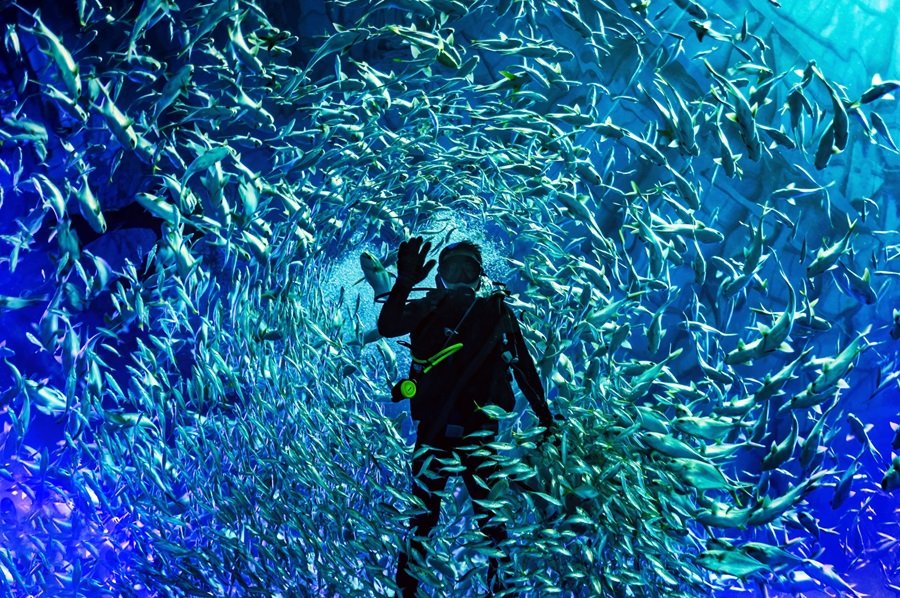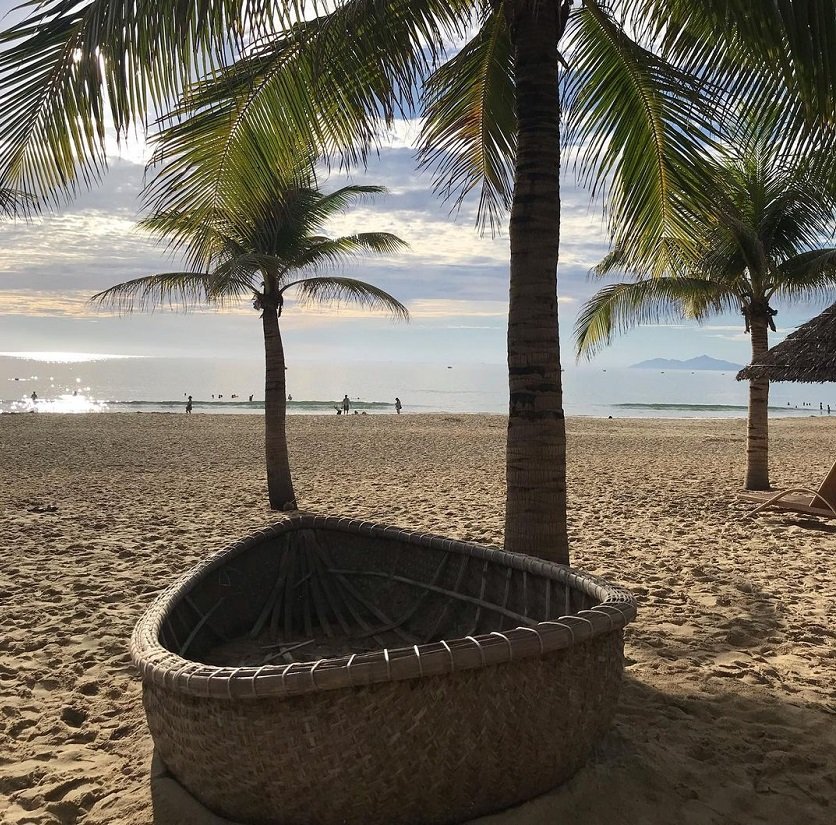Few places in Vietnam offer the kind of raw ocean beauty that Da Nang delivers. Nestled between green mountains and the turquoise South China Sea, this coastal city is more than just white-sand beaches and Instagrammable sunsets – beneath the surface lies a world full of wonder. Scuba diving in Da Nang is quickly becoming one of the must-try experiences for tourists craving adventure and connection with nature.
1. Is scuba diving in Da Nang worth trying?
If you are wondering whether scuba diving in Da Nang, Vietnam is worth adding to your itinerary, the answer is a solid yes. The coastal waters here are blessed with high visibility, minimal waves, and a vibrant range of marine life – from colorful coral to tropical fish darting through reef caverns.

Explore vibrant marine life while scuba diving in Da Nang’s crystal-clear waters (Source: Collected)The heart of scuba diving in Da Nang is Son Tra Peninsula, which is just a short ride away from the city center. This area is not just scenic from above; it is a whole other world underneath. Giant coral beds sprawl across the ocean floor, with clusters of sea anemones, crustaceans, and fish playing in the currents.
In Da Nang, multiple tour operators offer diving services tailored to different skill levels. You can go solo, join a group, or have a dive guide lead you through. Some packages even include GoPro footage, snacks, or even a BBQ on board – because who says your adventure has to end when you get out of the water?
2. Best time for scuba diving in Da Nang
Timing is everything, and for scuba diving in Da Nang, the sweet spot is from April to September. During this period, Da Nang enjoys its driest and sunniest weather. The sea is calm, the skies are mostly clear, and the water visibility is at its peak – often stretching up to 10 meters or more.
Avoid diving during the stormy season (October – December), when rainfall and waves can reduce visibility and increase safety risks. If you’re visiting outside of summer, keep an eye on the forecast and always check with your tour operator about the day’s conditions.

Calm seas and bright sun make the summer months ideal for Da Nang scuba diving (Source: Collected)
3. Best spots to experience Da Nang scuba diving
3.1. Son Tra Peninsula
Just 8 kilometers away from downtown Da Nang, Son Tra Peninsula is a prime spot for scuba diving. Its coral reefs are vibrant and healthy, teeming with colorful fish, sea stars, and occasionally octopus. Most of the best diving sites here are tucked along the coastline, hidden in secluded coves that feel like your own private world. A full-day dive tour typically costs around 600,000 VND per pax, which usually includes equipment rental, boat transport, and guidance from dive instructors.
3.1.1. Hon Sup Island
Hon Sup Island is a quiet gem off the coast of Son Tra. It is often chosen for beginners due to its shallow reef system and calm water conditions. The sea here is crystal-clear, revealing carpets of coral in pinks, purples, and yellows just a few meters below the surface. You might spot butterflyfish, sea cucumbers, and clownfish weaving through sea anemones.
3.1.2. Bai But Beach
Bai But Beach is one of the easiest places to access for scuba diving in Da Nang. The reef begins close to shore, so you do not need to venture far to find marine life. It is popular for first-time divers, and you’ll often see schools of small, silver fish swimming through tunnels formed by coral. The beach is also protected from strong waves, creating a safe environment for all.

Discover vibrant coral gardens while scuba diving in Da Nang (Source: Collected)
3.1.3. Bai Rang Beach
Bai Rang Beach is a favorite among repeat divers. The reefs here are layered and deep, forming natural canyons that are both eerie and beautiful. You can swim through mini caves, watch cleaner fish at work, or spot a lionfish if you are lucky. This area is also known for its visibility, which often stretches up to 10 meters on clear days. It is the kind of dive that keeps your adrenaline and curiosity fully engaged.
3.1.4. Bai Nam Beach
Bai Nam Beach offers a fascinating blend of hard coral structures and soft coral meadows. The biodiversity is stunning, with sponges, nudibranchs, and colorful reef dwellers in every direction. Because of its unique topography, it is great for intermediate-level divers who want more than just a quick look underwater. The descent here is gradual, which allows for longer exploration time without needing to go too deep.
3.1.5. Bai Bac Beach
Bai Bac Beach is for those who want a bit more of a challenge. It has slightly stronger currents and deeper waters, so it is ideal for certified divers looking to push their limits. The payoff is big: dramatic drop-offs, large coral formations, and a higher chance of spotting bigger marine creatures like stingrays or barracudas. You will feel like you have entered an untamed ocean frontier.

Deeper waters and stronger currents await at Bai Bac Beach (Source: Collected)
3.1.6. Bai U Beach
Bai U Beach flies under the radar, making it one of the most peaceful dive spots on Son Tra Peninsula. The seafloor here is a patchwork of coral blocks and sandy stretches, giving you different ecosystems to explore in one dive. You will likely be alone or with only a few other divers, which enhances the sense of connection with nature. It is especially good for underwater photography thanks to the minimal disturbance and gentle currents.
3.1.7. Bai Nghe Beach
Bai Nghe Beach is a hidden treasure when it comes to scuba diving in Da Nang – often overlooked by tourists but highly valued by local dive experts. Its coral reefs remain remarkably healthy and untouched, with very little human impact. Diving here feels like stumbling upon a secret marine sanctuary, far from the crowds. You will encounter a rich variety of fish, delicate coral formations, and, if you are lucky, a sea turtle cruising by in the quiet blue.
3.2. Cham Islands near Da Nang
Located about 45 kilometers off the coast of Da Nang, the Cham Islands in Hoi An are a paradise for scuba diving after traveling from Da Nang to Hoi An. These islands form part of a UNESCO Biosphere Reserve, which helps preserve their exceptional marine biodiversity.
Several top-tier dive spots dot the area. Hon Dai Island offers dramatic rock formations and deep swim-throughs for experienced divers. Hon Tai Island is rich with colorful coral gardens and playful reef fish. Bai Chong Beach provides calm, shallow waters ideal for beginners. Bai Xep Beach and Bai Huong Beach are better suited for more seasoned divers thanks to their strong currents and deep reefs.
The experience is both accessible and affordable, with full-day scuba diving tours priced between 500,000 and 800,000 VND per pax, often including equipment rental, boat transport, and lunch.

Take a day trip from Da Nang to the Cham Islands for scuba diving (Source: Collected)
4.1. What time should I go scuba diving?
The optimal hours are 8 AM to 11 AM or 2 PM to 4 PM. During these times, the sun is high enough to illuminate the seabed, bringing out the full color of the coral and marine life. Early mornings might be too chilly, and late afternoons reduce underwater visibility due to fading light.
4.2. What should I prepare?
- Swimwear and a towel
- Waterproof sunscreen
- Water shoes or fins
- A camera or GoPro
- Weather check
4.3. What should I note?
- Health first: Do not dive with a cold or after a big night out
- Hydration: Drink plenty of water before and after diving
- Equalize your ears: Always balance pressure during descent
- No touching: Corals are delicate and easily damaged
- Stay calm: If it is your first dive, relax and follow your guide. Panic is your worst enemy underwater.
Whether you are chasing coral reefs or drifting alongside shoals of tropical fish, scuba diving in Da Nang is an experience that stays with you. It is not just about what you see underwater – it is about how it makes you feel: alive, amazed, and connected to something bigger than yourself.







